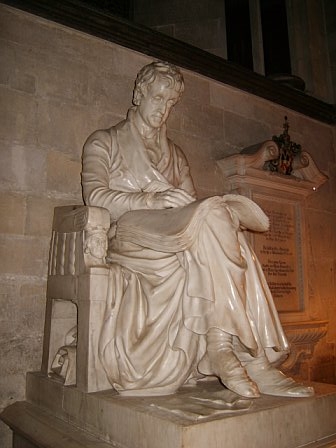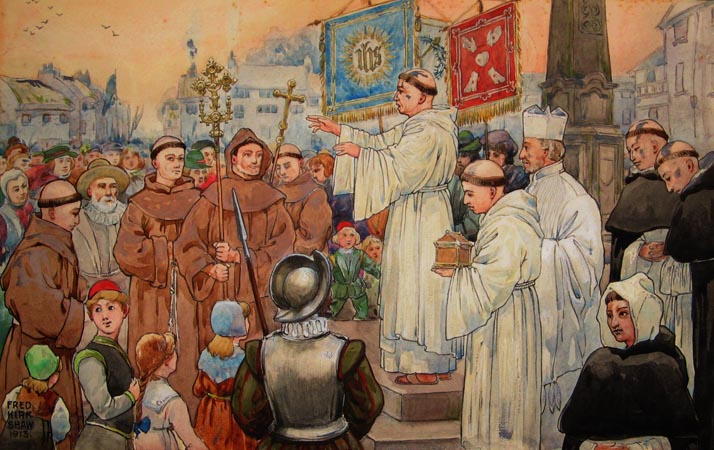|
John Brydges, 1st Baron Chandos
John Brydges, 1st Baron Chandos (9 March 1492 – 12 April 1557) was an English courtier, Member of Parliament and later peer. His last name is also sometimes spelt Brugge or Bruges. He was a prominent figure at the English court during the reigns of kings Henry VIII and Edward VI and of Queen Mary I. Biography He was born at Coberley, Gloucestershire, the son of Sir Giles Brydges of Coberley (c. 1462 – 1511) and Isabel Baynham. His father was a knight of the body to Henry VII and his brother Thomas Brydges of Cornbury, Oxfordshire also held public office and served as an MP. Bridges inherited his father's Oxfordshire and Wiltshire estates as a minor in 1511, and was for two years the ward of Sir Edward Darrell. He was knighted in 1513 after serving in France with Charles Brandon at Terouenne and Tournai. He attended Henry VIII on all subsequent state occasions in England and France (presumably including the famous meeting with Francis I of France at the Field of the Cl ... [...More Info...] [...Related Items...] OR: [Wikipedia] [Google] [Baidu] |
High Sheriff Of Wiltshire
This is a list of the Sheriffs and (after 1 April 1974) High Sheriffs of Wiltshire. Until the 14th century, the shrievalty was held ''ex officio'' by the castellans of Old Sarum Castle. On 1 April 1974, under the provisions of the Local Government Act 1972, the title of Sheriff of Wiltshire was retitled as High Sheriff of Wiltshire.Local Government Act 1972: Section 219 at legislation.gov.uk, accessed 28 April 2020: ”Sheriffs appointed for a county or Greater London shall be known as high sheriffs, and any reference in any enactment or instrument to a sheriff shall be construed accordingly in relation to sheriffs for a county or Greater London". Sheriff To 1400 *1066: Edric *1067–1070: Philippe de Buckland *1085: Aiulphus the Sheriff *1070–1105: < ...[...More Info...] [...Related Items...] OR: [Wikipedia] [Google] [Baidu] |
Henry VIII
Henry VIII (28 June 149128 January 1547) was King of England from 22 April 1509 until his death in 1547. Henry is best known for his six marriages, and for his efforts to have his first marriage (to Catherine of Aragon) annulled. His disagreement with Pope Clement VII about such an annulment led Henry to initiate the English Reformation, separating the Church of England from papal authority. He appointed himself Supreme Head of the Church of England and dissolved convents and monasteries, for which he was excommunicated by the pope. Henry is also known as "the father of the Royal Navy" as he invested heavily in the navy and increased its size from a few to more than 50 ships, and established the Navy Board. Domestically, Henry is known for his radical changes to the English Constitution, ushering in the theory of the divine right of kings in opposition to papal supremacy. He also greatly expanded royal power during his reign. He frequently used charges of treason and ... [...More Info...] [...Related Items...] OR: [Wikipedia] [Google] [Baidu] |
Siege Of Tournai (1513)
The Battle of the Spurs or (Second) Battle of Guinegate (, "Day of the Spurs"; ''deuxième bataille de Guinegatte'') took place on 16 August 1513. It formed a part of the War of the League of Cambrai, during the Italian Wars. Henry VIII and Maximilian I were besieging the town of Thérouanne in Artois (now Pas-de-Calais). Henry's camp was at Guinegate, now called Enguinegatte. A large body of French heavy cavalry under Jacques de La Palice was covering an attempt by light cavalry to bring supplies to the besieged garrison. English and Imperial troops surprised and routed this force. The battle was characterised by the precipitate flight and extensive pursuit of the French. During the pursuit a number of notable French leaders and knights were captured. After the fall of Thérouanne, Henry VIII besieged and took Tournai. Prelude Context Henry VIII had joined in the Holy League, as the League of Cambrai was also known, on 13 October 1511 with Venice and Spain to defend the ... [...More Info...] [...Related Items...] OR: [Wikipedia] [Google] [Baidu] |
Charles Brandon, 1st Duke Of Suffolk
Charles Brandon, 1st Duke of Suffolk, 1st Viscount Lisle, (22 August 1545) was an English military leader and courtier. Through his third wife, Mary Tudor, he was brother-in-law to King Henry VIII. Biography Charles Brandon was the second but only surviving son of Sir William Brandon, Henry Tudor's standard-bearer at the Battle of Bosworth Field, where Richard III was slain. His mother, Elizabeth Bruyn (d. March 1494), was daughter and co-heiress of Sir Henry Bruyn (died 1461). Charles Brandon was brought up at the court of Henry VII, and became Henry VIII's closest friend. He is described by Dugdale as "a person comely of stature, high of courage and conformity of disposition to King Henry VIII, with whom he became a great favourite." Brandon held a succession of offices in the royal household, becoming Master of the Horse in 1513, and received many valuable grants of land. On 15 May 1513, he was created Viscount Lisle, having entered into a marriage contract wit ... [...More Info...] [...Related Items...] OR: [Wikipedia] [Google] [Baidu] |
Edward Darrell (died 1530)
Sir Edward Darrell (1465/66 – 1530), of Littlecote, Wiltshire, was an English politician. He is chiefly remembered as the father of Elizabeth Darrell, who was a maid of honour to Queen Catherine of Aragon. Elizabeth had a notorious affair with the poet Sir Thomas Wyatt, by whom she had several children, and was later rumoured to have planned to become the sixth Queen of Henry VIII. He was the only son of Sir George Darrell of Littlecote (died 1474), Keeper of the Great Wardrobe to King Edward IV, and his second wife Joan Haute, daughter of William Haute. His father died when Edward was eight years old, and he succeeded to very substantial estates, the bulk of which were in Wiltshire: Littlecote House was the principal family residence. He had at least one half-sister Elizabeth, who married John Seymour: they were the grandparents of Queen Jane Seymour. Despite his Yorkist background, his loyalty to the Tudor dynasty was never seriously in doubt, and he prospered as a r ... [...More Info...] [...Related Items...] OR: [Wikipedia] [Google] [Baidu] |
Edward VI
Edward VI (12 October 1537 – 6 July 1553) was King of England and Ireland from 28 January 1547 until his death in 1553. He was crowned on 20 February 1547 at the age of nine. Edward was the son of Henry VIII and Jane Seymour and the first English monarch to be raised as a Protestant. During his reign, the realm was governed by a regency council because he never reached maturity. The council was first led by his uncle Edward Seymour, 1st Duke of Somerset (1547–1549), and then by John Dudley, 1st Earl of Warwick (1550–1553), who from 1551 was Duke of Northumberland. Edward's reign was marked by economic problems and social unrest that in 1549 erupted into riot and rebellion. An expensive war with Scotland, at first successful, ended with military withdrawal from Scotland and Boulogne-sur-Mer in exchange for peace. The transformation of the Church of England into a recognisably Protestant body also occurred under Edward, who took great interest in religious matters. His fat ... [...More Info...] [...Related Items...] OR: [Wikipedia] [Google] [Baidu] |
Peerage
A peerage is a legal system historically comprising various hereditary titles (and sometimes non-hereditary titles) in a number of countries, and composed of assorted noble ranks. Peerages include: Australia * Australian peers Belgium * Belgian nobility Canada * British peerage titles granted to Canadian subjects of the Crown * Canadian nobility in the aristocracy of France China * Chinese nobility France * Peerage of France * List of French peerages * Peerage of Jerusalem Japan * Peerage of the Empire of Japan * House of Peers (Japan) Portugal * Chamber of Most Worthy Peers Spain * Chamber of Peers (Spain) * List of dukes in the peerage of Spain * List of viscounts in the peerage of Spain * List of barons in the peerage of Spain * List of lords in the peerage of Spain United Kingdom Great Britain and Ireland * Peerages in the United Kingdom ** Hereditary peer, holders of titles which can be inherited by an heir ** Life peer, members of the peerage of the United ... [...More Info...] [...Related Items...] OR: [Wikipedia] [Google] [Baidu] |
Kingdom Of England
The Kingdom of England (, ) was a sovereign state on the island of Great Britain from 12 July 927, when it emerged from various Anglo-Saxon kingdoms, until 1 May 1707, when it united with Scotland to form the Kingdom of Great Britain. On 12 July 927, the various Anglo-Saxon kings swore their allegiance to Æthelstan of Wessex (), unifying most of modern England under a single king. In 1016, the kingdom became part of the North Sea Empire of Cnut the Great, a personal union between England, Denmark and Norway. The Norman conquest of England in 1066 led to the transfer of the English capital city and chief royal residence from the Anglo-Saxon one at Winchester to Westminster, and the City of London quickly established itself as England's largest and principal commercial centre. Histories of the kingdom of England from the Norman conquest of 1066 conventionally distinguish periods named after successive ruling dynasties: Norman (1066–1154), Plantagenet (1154–1485), Tudor ... [...More Info...] [...Related Items...] OR: [Wikipedia] [Google] [Baidu] |
Pilgrimage Of Grace
The Pilgrimage of Grace was a popular revolt beginning in Yorkshire in October 1536, before spreading to other parts of Northern England including Cumberland, Northumberland, and north Lancashire, under the leadership of Robert Aske. The "most serious of all Tudor period rebellions", it was a protest against Henry VIII's break with the Catholic Church, the dissolution of the lesser monasteries, and the policies of the King's chief minister, Thomas Cromwell, as well as other specific political, social, and economic grievances. Following the suppression of the short-lived Lincolnshire Rising of 1536, the traditional historical view portrays the Pilgrimage as "a spontaneous mass protest of the conservative elements in the North of England angry with the religious upheavals instigated by King Henry VIII". Historians have observed that there were contributing economic factors. Prelude to revolt The 16th century During the Tudor era there was a general rise in the population a ... [...More Info...] [...Related Items...] OR: [Wikipedia] [Google] [Baidu] |
Sieges Of Boulogne (1544–46)
{{disambiguation ...
Siege of Boulogne may refer to: *Siege of Boulogne (1492) *Sieges of Boulogne (1544–46) Siege of Boulogne may refer to: *Siege of Boulogne (1492) The siege of Boulogne took place during the autumn of 1492. Henry VII of England had led an expeditionary force of 12,000 troops across the Channel to Calais and began to besiege the Fren ... [...More Info...] [...Related Items...] OR: [Wikipedia] [Google] [Baidu] |








